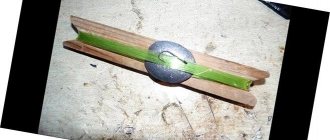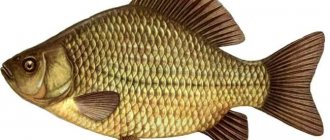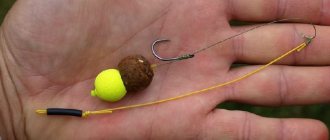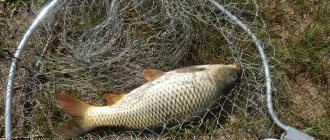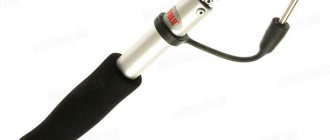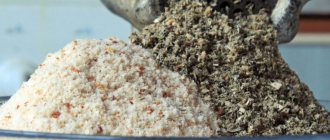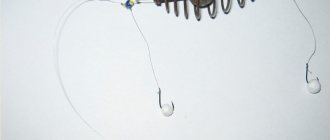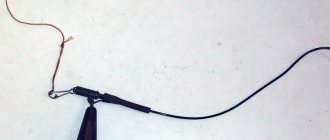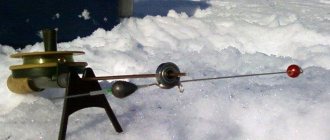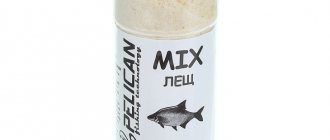Habitats and fishing calendar
Carp eat everything and almost without a break.
Its menu includes:
- Crustaceans.
- Shellfish.
- Insect larvae.
- Worms.
- Plant foods, etc.
An unpretentious individual, however, loves warmth, so it is not found in the northern regions.
In Russia it is caught in the southern and middle zones, abroad these are the countries:
- Hungary.
- France.
- Germany.
- Czech Republic.
- Australia.
- USA.
Habitat - reservoirs and lakes, a little less often - rivers. A big fan of calm areas where the water is still or moderately flowing. Selects places with a strong clay bottom with a small layer of silt. In summer it lives in underwater thickets, reeds, and snags. By winter, it goes deep into holes, falls into a dormant state, does not feed and does not move. With the arrival of spring, as soon as the water warms up to 10 degrees, the carp begins to move to the spawning grounds. Spawning begins at a water temperature of 18 degrees and continues almost throughout the summer.
Know: since the carp is strong and large, the tackle for it must be powerful enough. When fishing, they use a donkey, a feeder and a float tackle.
Advice: keep quiet while fishing for carp! This is a very cautious and timid fish; it does not like loud conversations or noise. In this case, he will simply refuse the bait.
Fishing calendar:
- Winter. It’s not worth catching carp, it’s a pointless activity. At this time, he is lethargic, does not feed or move, and uses the reserves accumulated earlier.
- Spring. Leaves winter quarters and begins searching for food. Since natural food is still scarce, fishing can be done with a good bite. This period ranges from mid-April to mid-May. Then spawning will begin and the fish will begin to bite poorly.
- Summer. Very energetic, constantly searching for food. The bite can be especially good in August - sensing the onset of cold weather, the carp tries to eat for future use and loses caution.
- Autumn. Until about mid-October, before the onset of cold weather, you can catch quite successfully, then it loses activity.
Please note: it bites well:
- On a warm and slightly cloudy day with a slight calm.
- Before the storm starts.
- A period of heavy rain followed by the arrival of stable weather.
- When the wind is from the south or southwest.
How to catch carp on a feeder in spring, summer and autumn
Catching carp with a feeder is possible when the water warms up above 10 degrees, when the fish begins to feed more intensively and move through the reservoir. The water warms up to this temperature by the beginning of April and remains at this level until November. In principle, this is the time of the feeder season, during which the bite is present with varying frequencies of its level, depending purely on the factors of weather changes. Let's consider the main periods of the season according to the time of the calendar year.
Spring

From the beginning of April, a full-fledged feeder season for carp begins, which is searched for on warm shallows, in clean areas of water. Small individuals are the first to respond to a bite. Large ones are waiting for warmer waters. In cold water, fish feed on the animal component, which the fisherman needs to take into account when using purely animal baits, worms, maggots and bloodworms as bait. The bait also includes animal supplements, chopped worms, crushed bloodworms and canned maggots. Immobilized components cause less concern to the fish and keep them on the feeding spot longer. They are caught in the spring throughout the daylight hours. Sunny weather has a particularly favorable effect on the bite.
Summer carp fishing
With the strong warming of the water, the fish become more active and the season, in the summer, enters a stable biting phase. Having gained good condition, the carp begin to pick and choose, sorting through the food. The fish switches to a plant diet and often ignores worms and maggots, switching to corn and pearl barley. The feeder installation for carp is refined and made more sensitive, because there is plenty of food and any alarming little thing will scare the trophy away from the fishing point.
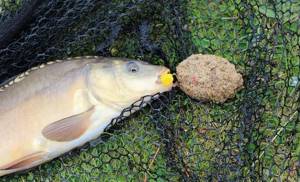
The fish tries to stay at long distances, at medium depths, up to two meters. They fish in the morning and evening, switching to night fishing in particularly hot weather. Any cold snap reduces the bite. In cloudy weather with drizzling light rain, the bite may not stop even during the day.
Catching carp in autumn on a feeder
With cold weather, fish move to deeper parts of the reservoir, staying on the edges of holes and underwater ravines. The secrets of catching carp in the fall on a feeder lie in the angler’s transition to hunting in the depths. Bites become less confident, the fish savors the bait longer. The exits themselves are shifted to lunchtime and evening hours. On cold mornings there may be no bite at all.
Fishing for carp on a feeder in the fall switches back to the use of animal baits. The bait is made more viscous by concentrating the supply on the smallest point possible. On sunny days, especially in the evening, fish may approach the heated water in the shallows.
Features of choosing feeders for carp
To make fishing successful, special attention must be paid to the correct bait and feeders.
Remember: using a feeder allows you to feed prey at a variety of distances from the shore. A feeder is a container with bait that is attached to a fishing line near the hook. The container sinks to the bottom and remains there throughout the entire fishing trip, gradually being released.

Feeders according to their structure are:
- Open. They are used mainly in reservoirs with weak currents and are filled with loose food. The ends of the feeder are open on both sides; most often they use some kind of porridge mixed with bloodworms or worms as a filler. The food gradually dissolves in the water and attracts fish to the fishing spot. Such feeders are especially effective on carp ponds.
- Half-closed. Used for fishing during currents. Additionally, they act as a sinker, preventing the line from moving to the side. In this case, lead is added to load them. Usually placed at the end of the line or left to slide along the leash.
- Closed. Designed for fishing in reservoirs with strong currents. These are containers of various shapes, most often cylindrical, with lids on the sides and holes for food outlet. They are mostly used for animal food - small moths, worms, maggots.
Installation of gear depending on the feeding habits of carp
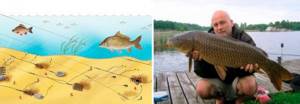
The installation of gear is based on the behavior of fish in a particular body of water. Carp are able to feed both from the bottom and in the water column, including from the surface, depending on weather conditions or time of day. The carp angler must know when and under what conditions carp choose the appropriate feeding method. Therefore, the installation option must correspond to the nature of the reservoir, time of year, time of day, etc.
If you choose the wrong installation, then it is unrealistic to expect to catch carp. In addition, carp fishing is fishing that is not designed for one day. Before you start fishing, you need to familiarize yourself with the bottom topography in order to identify promising places and only then start feeding a section of the water area.
Standard option
After the fish has discovered the bait and taken it into its mouth, it tries to move away. At this moment the leash is tightened. Due to the fact that the sinker has significant weight, the carp hooks itself and the hook sticks into its lip. This is the most common mounting option when fishing from the bottom. Under other fishing conditions, it is not possible to ensure self-hooking of fish.
Fishing. Float tackle. Simple catchy installation
Quick turn
For hooking to be effective, it is necessary to mount the equipment correctly. Reliable hooking is achieved through:
- Shifting the hair attachment point closer to the bend of the hook, thereby changing its center of gravity.
- Place a small pellet on the hair, a few centimeters away from the beginning of the hook barb.
- Attach a pellet weighing about 2 g to a leash, measuring 5 cm from the hook.
There are many options for turning the hook into the desired position. Quite often they use such a concept as Line Aligner, which means “line straightener”.
Techniques for using the Line Aligner:
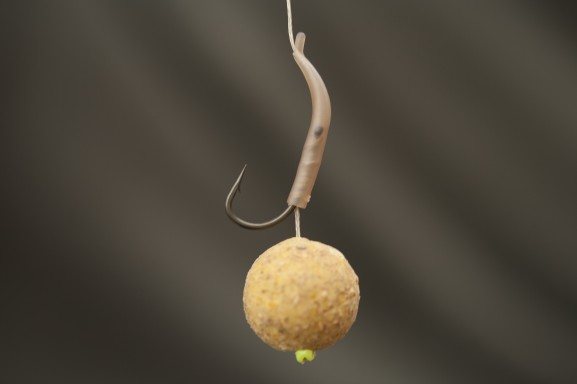
- The sheath of the leash is partially removed.
- A knot is tied around the shank of the hook.
- 2 knots are tied in front of the eye of the hook.
- A hole is formed in the heat shrink tube through which the leash is pulled.
- A tube is placed on the shank of the hook.
- It is good to fix the tube over the steam and give it a shape with a bend of 30-35° degrees.
As a result of such actions, the fishing line should be located in line with the sting of the hook.
Types of feeders according to body shape
Feeders for carp can be of different types and shapes, they are distinguished:
- "Spirals". Simple and great for long distance casting. They have a rounded spiral shape, the line runs inside a hollow central rod, which allows the structure to move freely along it. Fill with viscous mixtures - porridges, add clay and oatmeal.
- "Cells". They have a mesh metal body and come in different shapes: triangular, round, oval or square. Different shapes help cover almost all types of water bodies. Thus, round ones are used in standing water, triangular ones - in strong currents, since, thanks to the plane lying on the bottom, they are little exposed to the flow of water. Pros - they fly well and give away food, cons - they cling to obstacles. There is a built-in lead plate inside the feeder for weighting.
- "Tunnels ". They are used quite rarely, mainly by professional fishermen. Outwardly they resemble a long sponge twisted with threads. Before throwing it, it is lowered into a container with maggots, which make their way inside. Suitable for short casts.
- "Method". They are a lattice or frame onto which complementary foods are pressed. They can be different: from smooth to ribbed, but the main task remains one thing - to bring not only complementary food to the fishing site, but also bait, so that the fish will immediately grab it on the hook. The “method” is convenient in reservoirs with a thick layer of silt, since it does not get stuck in it, but lies like a pillow, attracting prey. Unlike mesh models, you can make any amount of complementary feeding by filling the feeder the way you want.

Criterias of choice
The final result of a “silent hunt” depends on the choice of a quality product, so it must meet a number of requirements:
- Be spacious - the more food you can throw into the water, the better.
- Very good quality.
- Be sure to securely fasten the load so that it does not fall off during the first drop.
- With high quality strong mesh.
- Made from durable materials.
- No defects: cracks, rust, missing elements.
- It is advisable to have a swivel for fastening to the fishing line.
Important : ensure the strength of all structural elements. Low-quality ones rupture in the adhesion zones and fail.
Making a makushatnik for carp
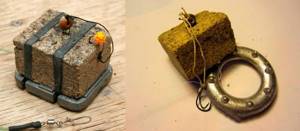
Makushatnik is the simplest equipment for catching carp and other types of fish. In this case, a briquette of makukha serves as a feeder, which soaks for a long time in water. Such equipment requires only a weight, sometimes of a special design, such as a “dovetail,” although many anglers make do with the simplest weight designs.
To form the gear you will need:
- lead plate, 5x3 cm in size;
- drills, 1.5 and 2.5 mm thick, as well as an electric drill;
- winding ring, clasp and swivel;
- hooks (from 1 to 4 pcs.);
- leash material;
- fishing line, 0.4 mm thick;
- rubber ring for fastening the briquette.
Manufacturing technology:
Bottom tackle Makushatnik for catching Carp. How to make Makushatnik with your own hands.
- 4 holes are drilled in the lead plate, located at the corners of the plates.
- A recess is made in the transverse part of the crown for a rubber ring.
- In the corners of the top bar, holes with a diameter of 1.5 mm are drilled for attaching hooks.
- Prepare leashes with hooks and secure them along the edges of the plates.
- Disguise the hooks in the crown by placing them in holes with a diameter of 1.5 mm.
- Secure the briquette of macadamia to a metal plate.
- A swivel and carabiner are attached to the winding ring.
How to make a carp feeder yourself
Carp feeders are quite a consumable item, which you often have to buy in addition, which costs a pretty penny. That’s why many master fishermen have learned to make them themselves.
Most often they are made:
- From women's hair curlers. It's easy and quick to do. The wire must be threaded through the curlers and the weight must be secured. Attach a swivel or ring to the feeder.
- From construction mesh. Cut out a small piece of mesh in the form of a rectangle. A base is also made from wire in the form of a rectangle and soldered to the mesh. A lead weight is placed inside. A hook is attached to the end.
- From plastic bottles. A blank of the required length and width is cut out of plastic and given the required shape. Use a hot nail to make holes, as many as needed. A weight is also attached and a loop is made using wire.
Types of gear for carp fishing
Catching carp is not easy. Often you come across trophies up to 8-10 kg, and a regular fishing rod can quickly break. When making it yourself, the main thing is the strength of the rod and the average diameter.
Kinds:
- is quite suitable ; you can also make it yourself.
- Float rod , as a popular tackle among fishermen, made from flexible walnut rods and strong fishing line. Suitable for fly rods, Bolognese rods, match rods, and plug rods. The main thing is to choose a fishing line of medium thickness and thick wire hooks.
- A variety of donks in the form of various feeders , which you can also prepare with your own hands. When catching carp, you can’t do without hooking, so you need to play with the feeders and do the wiring that way. The best fishing rod is a feeder rod, a rod with a spinning reel and a monofilament line with an elongation of 0.30 mm. When fishing for small specimens, homemade feeders, nipples, tops, and springs are suitable. There can be many options for self-production.
Installation of equipment
Professional fishermen know that correct installation of gear plays an important role for a successful hunt.
A beginner needs to know that the necessary set of equipment includes:
- Hook.
- Leash.
- Sinker.
- Anti-twist.
- Swivel.
Installation happens:
- Sliding. When the fish grabs the bait and hook, it freely pulls the leash and line.
- Self-locking. In prey that grabs the bait and begins to move, the hook digs deeper (hooks).
Today, there are many types of equipment installation, and progress continues to go in this direction.
Here are the most popular ones:
- "Paternoster". It is considered the easiest to perform, but nevertheless the most effective. With this installation, the feeder is attached to a twist, which is located on the main fishing line. This allows the leash not to twist with it. Excellent for fishing in muddy conditions.
- "Inline". An unusual rig in which the sinker is located on the axis of the anti-twist. It is made for particularly precise fishing of carp using bait with bait: as soon as the fish takes the bait, it immediately does not feel the resistance of the weight and the rod. And when it starts to float away, an obstacle appears in the form of a feeder and self-cutting occurs.
- "Helicopter". The sliding rig got its name due to the fact that in flight the leash rotates around the anti-twist. The advantage is that it can be used when fishing at long distances on any day.
- "Combine harvester." Suitable for muddy bottoms, easy to make and easy to use, suitable for large casts. Here the feeder is attached to the tube through a piece of fishing line, thus minimizing the threat of losing all the equipment in case of snags.
- "Symmetrical loop". Self-cutting equipment. Use in standing water. A simple loop pattern allows you to clearly convey the fish’s bite when it begins to move to the side.
- "Asymmetrical loop." A more improved version of the previous one, it protects the line from twisting and is perfect for fishing in very strong currents.
Important : make sure that the equipment is as invisible as possible to the fish in the water!
How to collect donka for carp
In this article, we are not considering sports carp or feeder gear; we are talking only about amateur fishing and all available equipment, the purchase of which does not require significant costs.
You don’t need to think that to catch trophy fish you need imported equipment, rods, reels and fishing lines, because carp have been successfully caught in our reservoirs since time immemorial, and there are no obstacles to continuing to do so.
Rod
The length of the rod is selected depending on whether the equipment will be brought in on a boat, or cast from the shore “by hand”. For imported fishing, budget telescopic or plug rods with a length of 2.7-3.00 are used, which are convenient to handle in cramped conditions while sitting on a boat.
For long-distance casting from the shore, you need a rod with a length of 3.3 - 3.9 with a cast of at least 100 grams. It doesn’t have to be a carbon “stick”; a “crocodile”, well known for its reliability and durability, capable of withstanding heavy loads, will also do.
We will not offer specific names of fishing rods, because the assortment in stores is different, the main thing you need to understand is that they catch no less fish with a budget form than with an expensive one, so it’s better to save money.
Coil
A spinning reel with a 4000-5000 spool is an ideal option, but in its absence, even a 3 thousand reel will provide convenience when casting and retrieving fish, even if it is somewhat more difficult to do. The technical characteristics of budget reels are not much worse than products from well-known brands, so don’t chase names, functionality is much more important.
Considering that amateur carp fishing involves a large number of rods, reducing the cost of gear is only welcome. But it’s better not to skimp on fishing line, especially if fishing is carried out in the current, in snags and hard-to-reach places. After hooking, the carp will probably show fierce resistance and in order to prevent it from going into the reeds or getting caught on snags, a strong and low-stretch line is needed.
fishing line
For fishing from the shore and casting, a monofilament line with a diameter of 0.3-0.35 mm is best suited. If you choose a thinner line, there is no complete confidence in the reliability of the gear, especially when you encounter a large fish. A main line with a diameter greater than 0.35 limits the casting range, and when fishing long-distance it is very difficult to accurately place the equipment at the point.
When fishing from a boat, especially in snags, it is best to choose a braided line with a diameter of 0.2-0.25 mm as a base. The low stretch of the braided cord makes it possible to make a clear hook, and when fishing, it is easier for the fisherman to hold the fish and not let it go into the reeds or snags.
The cost of braided cord is higher than monofilament fishing line, but with proper use it lasts for several seasons, the main thing is to dry the base after fishing and store it in a dark, cool place. Before fishing, be sure to check the condition of the fishing line, because it will be very disappointing if, when fishing for a trophy, the tackle breaks due to a poor-quality base.
Monofilament fishing line is also stored in a dark and dust-free place; in extreme cases, the reels are placed in plastic bags. Most often, more fishing line is wound onto the reel spool than is needed for fishing, and after several fishing trips it is rewound to another spool so that the working part remains fresh.
Leads hooks and sinkers
When fishing for carp, you need to be prepared for a trophy fish to bite, so the hooks you choose are strong and sharp. Every time before casting or bringing in the rod, check the sharpness of the hook, because your catch ultimately depends on it. Hook size 2-6 according to the classical classification, preferably Wide Gape shape, with a wide hook.
As for specific manufacturers, the choice depends on the fisherman’s budget; the best option is Hayabusa KX-1 hooks. This is a budget, but high-quality hook that can hold trophy fish.
Now there are many good Chinese hooks, but you need to choose them only after visually verifying their high quality and sharpness. To knit leashes, use soft leash material or a strong cord that ensures the reliability of the tackle.
Important! Remember that inattention when choosing a hook and tying the rig will result in an unfortunate loss of fish.
Cargo requirements:
- dark, better camouflage color;
- weight sufficient to hold the current and hook the fish on its own;
- streamlined shape (bullet, cylinder).
Homemade cast weights do their job well, and you can paint them a camouflage color using dry paint. Using such cargo is another opportunity to save money.
Features of the choice of bait and bait
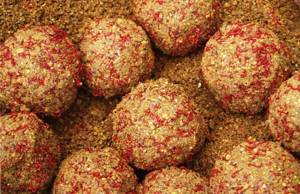
It is almost impossible to catch carp without using special bait. Nowadays there is quite a large selection of such products in stores, however, experienced fishermen advise making it yourself.
Make sure that it meets the needs of the carp representative:
- It exuded an aroma that evoked a good appetite.
- Consisted of fresh ingredients.
- Not overloaded with ingredients, at most 5 items.
- It should be easy to mold while remaining fairly hard.
Remember: if there is a current in the fishing area, the food is thrown against it. Throw while making as little noise as possible.
The best baits are:
- Red worms.
- Maggots.
- Bark beetles.
- Dragonflies and their larvae.
- Cottage cheese.
- Bread.
- Pearl barley.
- Corn.
- Peas.
- Potato.
Information : there are some peculiarities in their use depending on the season and fishing conditions. So, in the spring it is better to take worms, corn and dough baits. In the fall, it is worth relying on material of animal origin, since winter is approaching and the fish are in a hurry to eat.
For fishing, insect larvae are taken from the bottom, because there they look quite natural. In a reservoir with a lot of silt, you should not take the dough, it will soon lose its shape.
Feeder equipment for carp
The rigs are tied depending on the activity of the fish. For passive and cautious fish, an asymmetrical loop, inline installation, and hair rigs are used. For active fish, paternoster tying, the flat method, a rocker, nipples and springs loaded with food and hooks are used. For the convenience of casting and reeling out rigs, as well as quickly replacing equipment, swivels and fasteners are used. Buffer beads are placed in front of the knots to prevent deformation of the knitting material. Leashes are made from monofilaments that are an order of magnitude thinner than the main cord itself. Depending on the type of equipment, their length can vary from 7 to 30 centimeters.
Important! The more active the fish, the shorter the leash and vice versa.
Up to seven leashes can be used simultaneously on rocker arms, springs and nipples. Among the auxiliary equipment, various kinds of bite alarms and rod stands in the form of tripods and rod pods help to catch carp on a feeder much more comfortably.
Rules for catching carp on a feeder
There are several simple rules for catching carp on a feeder, following which you will always have a trophy:
- Fill it with the most delicious fish food;
- Constantly supplement the fishing area depending on the circumstances;
- Throw the feeder into a place where you suspect there are fish;
- The bait should be beyond the suspicion of the carp and easily eaten.
And finally, some tips for successful fishing:
- Do not soak the bait in tap water; prepare it immediately before fishing - with water from the pond where you are going to fish.
- You shouldn’t cast your gear without preliminary bait.
- Before casting, check the feeders, they must be in good working order.
- Change complementary foods constantly - at approximately 10-minute intervals.
Armed with the necessary knowledge and equipment, patience and ingenuity, you will definitely be able to show off your catch!
Basic elements for carp fishing
- A rod up to 3-4m long as the main element of equipment for catching carp. A fiberglass spinning rod made in China will do just fine, which you can buy for 400 rubles. in a fishing shop. Fiberglass is not inferior to expensive carbon fiber and is suitable for catching large carp with dough bait up to 250 g.
- The reel is innovative, excellent for catching carp, as it is quite powerful and reliable, not inferior in performance to spinning models. But not suitable for beginners. The best option is to purchase an inertia-free feeder model from the company: salmo, okuma, cormopan.
- The leash can be invisible or neutral. It is better to choose a short leash for good visibility of bites due to the flat body of the carp. So that the weight is clearly visible to the carp and occupies a central position in the water in relation to the feeder. If you have a short leash, the casting distance of the casting equipment will increase significantly.
- Regular and monofilament fishing line is preferable. Some fishermen use braided cord, which is quite sensitive. The diameter of the fishing line for carp is 0.4-0.5mm. The best option is a specially purchased carp line in a store with a fairly high stretch coefficient. It will serve as an excellent shock absorber when fishing for large fish.
- The main thing is to select the sinker taking into account the terrain conditions and the weight of the bait , so that the equipment is held at the bottom regardless of the composition of the bait. She easily made the marks herself and quickly notified the fisherman about the beginning of bites.
- Hooks should be bent inward or bent back with a sting. The first option is best, as reliable and sharp hooks are quickly swallowed by the fish, which gives a greater chance of hooking.
